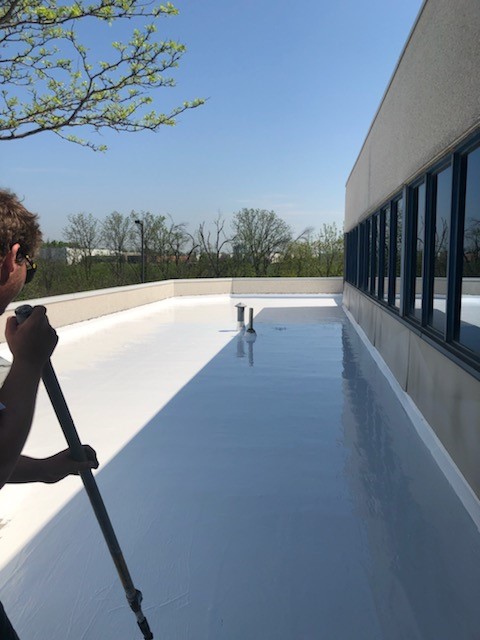When it comes time to replace or rehabilitate a commercial roof, business owners have a number of choices to make. One of the most important decisions is what type of roofing product to use. There are many different types of products on the market, but two popular options are polyurethane and silicone roof coatings.

In this blog post, we will compare polyurethane and silicone roof coatings and explain which might be the better option for your roof.
Polyurethane Coatings vs. Silicone Coatings
Both polyurethane and silicone are elastomeric roof coatings that are designed to stretch and contract with the movement of the roof. Polyurethanes typically have a higher solids content than silicone roof coatings.
Application
Both types of roof coatings can be applied via roller or spray application. As they are coatings both will allow you to rehabilitate an existing roof by coating overtop as opposed to having to remove the existing roof which will save time, money, and prevent additional material from going to landfill reducing the environmental impact.
Cool Roofs
Both polyurethane and silicone coatings are available in white colour with high SRI values. This is advantageous as these highly reflective coatings reduce a building’s cooling demand in the hotter summer months which reduces strain on the electrical grid. This in turn reduces the number of brown outs and black outs. The greater the number of buildings with these “cool roofs” in an area the greater the reduction in outdoor air temperature of that area as these roofs reflect the sun’s rays back into the atmosphere which slows the production of ground-level ozone, otherwise known as smog.
Ponding Water
When it comes to low slope/flat roofs both polyurethanes and silicones are excellent from a waterproofing perspective. Often with low slope or flat roofs, there are areas that are not sloped properly to the drains which can lead to ponding water on the roof. Both polyurethanes and silicones are great with ponding water, which won’t have an effect on them, vs. acrylic coatings which are water based and will wear down with exposure to ponding water leading to roofing failures.
Pedestrian Traffic
As both of these products are coatings, they can be slippery when wet. Generally, it is recommended to broadcast aggregate into the coatings in clearly marked pedestrian traffic areas/pathways leading to areas on the roof that need to be serviced, e.g., HVAC units.
Tear and Impact Resistance
This brings us to where the coatings can start to differ. When it comes to servicing items like HVAC units or cooling towers, tools can be dropped. Of the two coating options, polyurethane is the much stronger coating and will not puncture easily if a tool is dropped or outdoor furniture is dragged across its surface. The same cannot be said of silicones which can puncture easily.
Dirt Build Up
Another issue with silicone coatings is that silicone is known to be a dirt magnet attracting dirt and other airborne particles. This can cause a gradual build-up on the roof that can make the coating system more susceptible to heat from the sun, and thus less reflective, which negatively impacts the advantages you would have with a “cool roof”. To get around this the roof would need to be pressure washed every six months or so. This is not an issue with polyurethane roofs.
Future Roof Replacement or Repairs
The last major difference would be from a future roof replacement or repair scenario. Polyurethane roofs are looked at as “Forever Roofs” in that once they hit that 15 to 20 year mark their lifespan can be extended by another 15 to 20 years by the reapplication of a polyurethane top coat over top of the existing roof. Essentially, you would solvent wipe the previous polyurethane roof topcoat and then roller or spray apply the new polyurethane topcoat overtop. It also allows for very easy roof repairs if they are required.
With silicone coatings nothing likes to bond to silicone, not even silicone. This causes issues both from a roof replacement and from a repair perspective. When the roof is at the end of its life instead of reapplying a new topcoat, you will likely need to remove the silicone membrane before you can install the new roofing system.
Contact IMC Distributors for Polyurethane Roof Coatings in Canada
If you are looking for the best polyurethane roof coatings in Canada, look no further than IMC Distributors. We offer a wide range of polyurethane roof coatings, from commercial to industrial grade. Our team of experts can help you find the perfect coating for your roof, whether it is a new build or a re-roof. Contact us today to learn more about our products and see how we can help you protect your roof.
 Karli Logan is the Owner and President of IMC Distributors which is the exclusive partner of Nukote Coating Systems in Canada. With a B.Sc and M.Sc, as well as a demonstrated history of working across a number of industries, she has a passion to drive significant gains and benefits for IMC’s clients.
Karli Logan is the Owner and President of IMC Distributors which is the exclusive partner of Nukote Coating Systems in Canada. With a B.Sc and M.Sc, as well as a demonstrated history of working across a number of industries, she has a passion to drive significant gains and benefits for IMC’s clients.